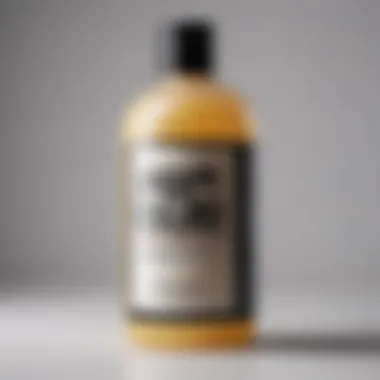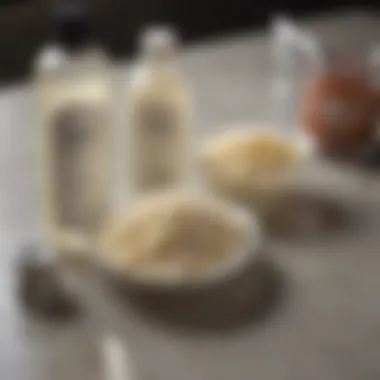Best Hair Bleach to Buy: A Comprehensive Guide


Intro
When it comes to hair transformation, bleaching is a pivotal step for many individuals seeking a new look. Choosing the right hair bleach can significantly affect the outcome and the health of your hair. This article delves into the best hair bleach to buy, analyzing various products thoroughly by examining ingredients, effectiveness, and suitability for diverse hair types.
Selecting a high-quality bleach is not just about achieving lighter hair. It involves understanding the chemistry behind hair products, how various components interact with the hair structure, and their potential impact on your overall hair health. Moreover, this comprehensive guide aims to provide insights into application techniques, aftercare, and possible side effects, ensuring you are well-informed before making a purchase.
By synthesizing information from expert recommendations and product reviews, we aim to equip you with the knowledge necessary for making educated decisions. Whether you are looking to dramatically lighten your hair for a bold change or maintain your current shade, this guide serves to enhance your understanding and provide a path to achieving safe and satisfactory results.
Understanding Hair Bleach
Understanding hair bleach is crucial for anyone contemplating a change in hair color. This section will delve into the types of hair bleach available, how they operate, and their importance. Hair bleaching is not merely a cosmetic procedure; does it also involve chemistry. A good understanding can prevent disasters, such as uneven tones or unexpected damage to hair.
What is Hair Bleach?
Hair bleach is a chemical product used to lighten the color of hair. Its primary function is to remove pigment from the hair strands. Typically, bleach comprises powerful ingredients that break down the natural pigments. The desired effect can be lightening of dark hair to blonde, or achieving more whimsical colors by stripping the natural base.
How Does Hair Bleach Work?
The process of hair bleaching relies on oxidation. When bleach is applied to hair, it penetrates and opens hair's outer layer, or cuticle. The active ingredients, particularly hydrogen peroxide, react with the melanin in hair, leading to its decolorization. The strength of the bleach is often measured by the volume of peroxide it contains, which determines how much lift can be achieved. It is critical to understand that higher volumes can lead to more significant damage, so informed choices are essential.
Types of Hair Bleach
Hair bleach comes in several formulations, each suited to different needs.
Powdered Bleach
Powdered bleach is a popular choice among professionals. It typically provides a strong lift and allows for customization in mixing. A key characteristic of powdered bleach is that it can be mixed with different volumes of developer to increase or decrease its lifting power. This flexibility makes it a go-to option for stylists. However, powdered bleach can be drying, requiring careful monitoring during application to avoid excess damage.
Cream Bleach
Cream bleach has a thicker consistency compared to its powdered counterpart. This significant aspect allows for easier application, especially on longer hair. Cream bleach is often gentler on hair, as it includes moisturizing agents that help protect strands during the bleaching process. Its unique feature is that it usually adheres better to the hair, reducing the risk of patchy results. On the downside, cream bleach might not provide as much lift as powdered formulas.
Liquid Bleach
Liquid bleach is designed for straightforward application and is ideal for root touch-ups. Its texture allows for swift and even distribution, making it a favorite for quick jobs. The key characteristic of liquid bleach is that it often lifts color efficiently with minimal effort. However, it may lack the strength needed for significant color changes, leading to disappointing results on darker shades. Therefore, users should weigh its convenience against its limitations.
"Choosing the right type of hair bleach is fundamental for achieving the desired color while minimizing damage to the hair."
Each type of hair bleach caters to specific needs and skill levels, making it crucial to select the appropriate one for your unique situation.
Key Ingredients in Hair Bleach
Understanding the key ingredients in hair bleach is crucial for anyone considering hair lightening. The effectiveness and safety of the product you choose largely depend on what goes into it. Each ingredient serves a distinct purpose and affects the hair in specific ways. Knowledge of these components can guide you to choose a suitable option tailored for your hair type and desired outcome.
Hydrogen Peroxide
Hydrogen peroxide is probably the most recognized ingredient in hair bleach formulations. It acts as an oxidizing agent, effectively lifting the natural color from the hair. How it works is simpler than it seems; when applied, hydrogen peroxide penetrates the hair shaft and opens up the hair cuticle. This allows the melanin, which is the pigment responsible for hair color, to be effectively shattered, resulting in a lighter shade.
The concentration of hydrogen peroxide varies among products. Stronger concentrations provide more lift but can increase the risk of damage. Therefore, knowing your hair's condition and the desired lift level is essential when selecting a bleach involving hydrogen peroxide.
Ammonia


Ammonia is another key ingredient in most hair bleaches. It functions primarily as an alkaline agent. This alkalinity allows the product to swell the hair and facilitate the absorption of hydrogen peroxide into the hair fibers. The result is a more significant lift in color. However, ammonia can also lead to increased hair damage and dryness. Many brands now offer ammonia-free options, which might be a more suitable choice for those with sensitive or damaged hair.
When evaluating hair bleaches, consider the use of ammonia. Understand your hair’s needs and sensitivities, as it often plays a key role in damage during the bleaching process.
Additional Additives
In addition to the primary ingredients, many hair bleaches contain additional additives designed to improve performance and reduce potential damage. Two notable categories of these additives are conditioning agents and bond protectors.
Conditioning Agents
Conditioning agents are designed to help maintain the hair’s moisture balance during the bleaching process. They can significantly counteract the harshness often associated with bleaching. The inclusion of conditioning agents is a key characteristic that makes certain bleaches more appealing.
One of the most beneficial aspects is that they help to minimize dryness and brittleness after treatment. With less damage, hair can remain more manageable and healthy-looking. The downside, however, is that not all conditioning agents provide equal protection, so it is vital to check product reviews and ingredient lists to ensure sufficient quality.
Bond Protectors
Bond protectors are another essential additive that helps to safeguard the hair structure during the bleaching process. They work by preventing the breakage of the internal bonds within the hair caused by the bleaching agents. This characteristic is increasingly popular among professional-grade bleaches.
The unique feature of bond protectors is their ability to bolster hair strength while undergoing chemical processes. This could lead to fewer damaged or broken strands post-bleach, which is a significant advantage for anyone aiming for multi-tone colors or lighter looks. Still, it’s crucial to recognize that the effectiveness of bond protectors can vary, and using them doesn't eliminate the risk of damage.
While the right ingredients can make a significant difference, understanding your hair's individual characteristics is just as important.
Factors to Consider When Buying Hair Bleach
Choosing the right hair bleach is a pivotal decision for anyone looking to lighten their hair. Various factors come into play here. Understanding these will help you make a choice that aligns with your hair type, your goals, and your sensitivity levels. A correct selection not only influences the desired outcome but also affects overall hair health.
Hair Type and Condition
Each individual has a unique hair type ranging from straight to curly, fine to coarse, and healthy to damaged. This variation is crucial when selecting a bleach. For instance, fine or damaged hair may be more prone to breakage and may require gentler formulas. On the other hand, thicker hair types might withstand stronger bleaches better. Also, assessing the condition of your hair is vital.
If your hair has been previously processed or chemically treated, it might be more susceptible to damage. Using a bleach made for sensitive hair types can minimize the risk. Look for features like conditioning agents in the bleach to mitigate potential injury. Ultimately, knowing your hair type and its condition will guide you toward the most suitable product.
Desired Lift Level
The term "lift" refers to how many levels lighter you want your hair to go. Different bleaches offer varying levels of lift, and this factor will greatly affect your choice. For lighter shades, a higher lift can sometimes be necessary, especially if you're starting from a darker base color.
Bleaches that offer more than three levels of lift are ideal for those looking to go very light. Users should confirm that the bleach is capable of achieving their desired result. For moderate lifts, lower-level bleach may suffice. If you are unsure, consider consulting with a stylist to determine the appropriate strength for your desired look.
Sensitivity to Chemicals
Hair bleach often contains strong chemicals like ammonia or hydrogen peroxide, which can be harsh on your skin and hair. If you have a history of allergic reactions, it is critical to choose a bleach that is labeled as hypoallergenic. Some products are specifically designed for sensitive scalps, offering lower chemical concentrations. Conducting patch tests before applying a new product to your hair helps to ensure that you won’t experience adverse reactions.
It's also wise to consider aftercare options and products that can assist in restoring your hair's moisture post-bleach.
Always prioritize safety and hair health when selecting bleach.
Taking these factors into account will lead to a more informed decision, ensuring that the hair bleach you choose is not only effective but also suitable for your individual hair needs.
Best Hair Bleach Products on the Market
When considering a change in hair color, particularly through bleaching, selecting the right product is essential. This section presents an overview of the most effective hair bleach products currently available. It discusses not only the products but also their specific benefits for different hair types and applications. Understanding these products helps users make informed decisions, ensuring that the desired results are achieved safely and effectively.
Top Powdered Bleach Options


Highlights
Highlights is known for its effective lightening ability. This powdered bleach is recognized for its versatility in use, making it suitable for various bleaching techniques including highlights and full-head applications. The key characteristic that sets Highlights apart is its ability to lift color without significant damage when applied correctly. It is a popular choice among professionals and home users alike due to its reliability. One unique feature of this product is its inclusion of conditioning agents, which help maintain hair health during the bleaching process. However, caution is necessary, as overuse can lead to dryness or breakage for some hair types.
Wella Blondor
Wella Blondor holds a strong reputation in the hair care industry. This bleach is known for providing consistent results and heavy lifting capabilities. Its key characteristic is the ability to lighten dark hair while minimizing yellow undertones. This makes it an ideal gift for users wanting a cooler blonde finish. Wella Blondor’s unique feature lies in its formula that adapts to different hair textures, allowing for a tailored bleaching experience. While it delivers excellent results, users must monitor the process closely to avoid over-processing the hair.
Recommended Cream Bleach Products
Clairol Professional
Clairol Professional cream bleach is designed for ease of use. Its creamy texture ensures an even application, reducing the risk of patchiness. The product’s specific aspect lies in its blend of components that enhance lift while also contributing to hair softness. Its key characteristic is the inclusion of various conditioners, which nourish the hair during the bleaching process. Because of these features, Clairol Professional is considered a beneficial choice, especially for those new to home bleaching. However, users should still perform a patch test to gauge sensitivity and prevent adverse reactions.
’Oreal Quick Blue
L’Oreal Quick Blue is a well-regarded product in the bleaching community. It stands out for its strong lifting power and rapid action. The key characteristic of L’Oreal Quick Blue is its ability to lift hair color dramatically in a short amount of time. This is particularly advantageous for users looking for quick results. The unique feature of this bleach is its dust-free formula, which minimizes mess and allows easier handling. However, its potency means that beginners should proceed with caution, ensuring they do not leave it on longer than recommended.
Effective Liquid Bleach Choices
Schwarzkopf Blondme
Schwarzkopf Blondme is respected for its advanced formula tailored for professional applications. Its specific aspect is that it provides personalized results based on hair porosity. This product's key characteristic is the customization aspect, which allows for tailored lightening. Schwarzkopf Blondme’s unique feature is its anti-yellow complex that helps maintain a natural blonde shade. Despite its high performance, some users may find it pricier than other options, which is a consideration for those on a budget.
Ion Sensitive Scalp
Ion Sensitive Scalp is specifically formulated for those with delicate hair or scalps. Its vital characteristic is its gentleness, making it a suitable option for individuals prone to chemical sensitivities. The unique feature of this product is its formulation that minimizes irritation while still effectively lightening hair. This product is seen as a beneficial choice for anyone concerned about damaging their hair or scalp during the bleaching process. However, users should note that while it is milder, the lifting potential may be less than that of harsher bleaches.
How to Properly Apply Hair Bleach
Understanding how to correctly apply hair bleach is essential for achieving the desired result without damaging your hair. The application process involves preparation, technique, and timing. Each of these elements plays a crucial role in ensuring a successful bleaching experience. Taking the time to learn these steps can significantly enhance the final color and maintain hair health.
Preparation Steps
Preparation is the foundation of a successful bleaching process. It sets you up for the results you want while minimizing risks.
Choosing the Right Tools
Choosing the right tools for bleaching hair is vital. The right tools can ensure a more even application of the bleach, which leads to a uniform color. Key tools include a mixing bowl, a brush for application, gloves to protect your hands, and a shower cap to cover your hair during processing. These items help create a controlled environment where you can execute your technique effectively.
A unique feature is using a brush instead of your hands, as it allows for precision. This is beneficial for achieving highlights or specific sections. However, it is critical to ensure that the tools are clean to avoid any cross-contamination or unexpected reactions.
Protecting Your Skin and Hair
Protecting your skin and hair during the bleaching process cannot be overlooked. The strong chemicals in hair bleach can cause irritation if they come into contact with your skin. Therefore, skin protection is a necessary step. Use a barrier cream around the hairline, and always wear gloves. This not only shields your skin but also enhances your confidence during application.
The unique feature of using barrier creams is that it creates a physical shield against the bleach. Its main advantage is that it can significantly reduce the risk of chemical burns, which might occur otherwise if you accidentally apply bleach onto your skin. Ensuring to follow these protective measures can help avoid discomfort and achieve better results.
Application Techniques
Once you have prepared adequately, the next step is mastering the application techniques. The method you choose can greatly affect the outcome. Applying bleach in sections is often recommended. Working through layers ensures more thorough coverage and minimizes the chance of missing spots. Use the brush to apply the bleach generously but evenly, ensuring that each strand is saturated. This will allow for a consistent lift throughout your hair.
Timing and Monitoring


Timing is a critical aspect of hair bleaching. The longer the bleach is left on, the more pronounced the lightening effect is. However, this comes with risks. Monitoring the process is essential to prevent damage. It's advisable to check the hair every five to ten minutes. Keep an eye on the color lifting, and consider your hair’s health and texture. If you notice any signs of excessive damage or irritation, rinse the bleach out immediately.
In summary, understanding how to properly apply hair bleach involves careful preparation and attention to detail. From the tools you use to the techniques and timing, every step can influence your results. By adhering to these aspects, you can enjoy a safer and more effective bleaching experience.
Aftercare Following Bleaching
After bleaching, hair often faces challenges that require careful management. Understanding the importance of aftercare is essential for maintaining hair integrity, color vibrancy, and achieving long-lasting results. The bleaching process can strip hair of natural moisture and weaken its structure. Proper aftercare helps mitigate damage and promote healthy hair. Aftercare should not be viewed as an afterthought but as a crucial step in the hair care routine. This ensures that the hair remains vibrant and manageable.
Key Elements of Aftercare:
- Moisturization: Hydration is vital to maintain the hair's moisture balance.
- Color Protection: Specific products can help preserve the color shine.
- Damage Repair: Hair often requires extra care to repair any structural damage from bleach.
Adopting a solid aftercare regimen will benefit the health and appearance of bleached hair significantly.
Potential Side Effects of Hair Bleaching
Bleaching hair is a popular method to achieve lighter shades or trendy looks. However, it is crucial to understand the potential side effects associated with this process. Knowing these risks allows users to make informed choices and mitigate damage. Safety should always be a priority, especially when it comes to beauty treatments. Overly aggressive bleaching can lead to unwanted consequences that may affect both the hair and scalp.
Understanding Damage Risks
When hair is bleached, the chemical agents penetrate the hair shaft to break down its melanin content. This process inevitably alters the structural integrity of the hair. Common damage risks include:
- Dryness: Hair may lose its natural moisture, making it brittle.
- Breakage: Weakened hair can snap easily under pressure,
- Frizz: Damaged hair often behaves unpredictably, leading to frizz and an unkempt appearance.
These issues underscore the importance of using bleach products with caution. Choosing the right product and following proper application techniques can reduce damage. Additionally, investing in good aftercare practices will help. Regular conditioning can replenish moisture and improve hair texture.
Identifying Allergic Reactions
Allergic reactions are another significant concern when using hair bleach. Ingredients like ammonia and hydrogen peroxide can irritate the scalp or skin. Symptoms of allergic reactions can include:
- Itching and Redness: These can occur at the application site.
- Swelling: In more severe cases, swelling might be seen in the scalp or surrounding areas.
- Burning Sensation: Some individuals may experience discomfort during or post-application.
Conducting a patch test before full application is essential. This simple test can determine if there is any adverse reaction to the bleach. If any negative response occurs, it is best to seek alternative products that may be less harsh.
Always prioritize safety. Understanding the risks and potential reactions can help maintain healthy hair and scalp throughout the bleaching process.
Avoiding damage and allergic reactions is possible through informed choices and careful application. The knowledge gained about side effects can lead to a more successful hair-lightening experience.
Expert Tips for Successful Bleaching
When it comes to hair bleaching, expertise can greatly enhance the results. A successful bleaching process is not simply about picking a product; it requires a nuanced understanding of timing, technique, and post-care. Knowing these can help avoid common pitfalls and achieve the desired hair color more efficiently.
Our Top Recommendations
To ensure optimal results, several techniques can be integrated into the bleaching process:
- Conduct a Strand Test: Before applying bleach to your entire head, always perform a strand test. This allows you to see how your hair reacts to the bleach and gauge how long to leave it on without causing irreversible damage.
- Follow Instructions Carefully: Different products have different formulations. Following the specific instructions provided by the manufacturer is essential.
- Use Quality Tools: Invest in professional-grade application tools like brushes, bowls, and gloves. This can make the process easier and more precise.
- Warm Your Bleach Mix: Slightly warming your bleach mix can enhance effectiveness. However, do this cautiously to avoid overheating and compromising the product’s integrity.
- Work in Sections: Divide your hair into manageable sections. This strategy ensures even application, which is key for consistent results.
Common Mistakes to Avoid
Certain missteps can derail the bleaching process:
- Over-Processing: Leaving bleach on too long can lead to irreparable damage. Trust your strand test and set timers.
- Ignoring Hair Type: Not all hair types react the same way to bleach. Consider your own hair’s texture and condition before choosing a bleach strength.
- Neglecting Aftercare: Post-bleach care is as important as the application. Skipping moisturizing treatments can exacerbate dryness and damage.
"Proper aftercare will maintain your hair’s health and help the color last longer."
- Using Product Mix Proportions Incorrectly: Adhering to the product’s mixing ratio is critical. Incorrectly mixed bleach can lead to uneven outcomes and affect lift.
By applying these expert tips and avoiding common traps, men interested in fashion and style can achieve vibrant, healthy-looking hair. Understanding hair bleach leads to better choices and outcomes, elevating individual style to a new level.















